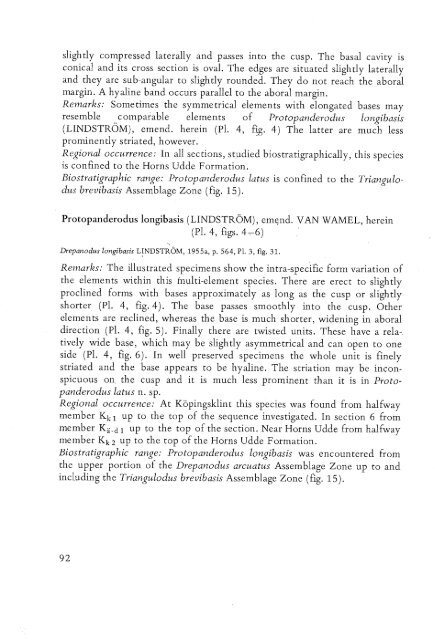UTRECHT MICROPALEONTOLOGICAL BUllETINS
UTRECHT MICROPALEONTOLOGICAL BUllETINS
UTRECHT MICROPALEONTOLOGICAL BUllETINS
You also want an ePaper? Increase the reach of your titles
YUMPU automatically turns print PDFs into web optimized ePapers that Google loves.
slightly compressed laterally and passes into the cusp. The basal cavity is<br />
conical and its cross section is oval. The edges are situated slightly laterally<br />
and they are sub-angular to slightly rounded. They do not reach the aboral<br />
margin. A hyaline band occurs parallel to the aboral margin.<br />
Remarks: Sometimes the symmetrical elements with elongated bases may<br />
resemble comparable elements of Protopanderodus longibasis<br />
(LINDSTROM), emend. herein (PI. 4, fig. 4) The latter are much less<br />
prominently striated, however.<br />
Regional occurrence: In all sections, studied biostratigraphically, this species<br />
is confined to the Horns Udde Formation.<br />
Biostratigraphic range: Protopanderodus latus is confined to the Triangulodus<br />
brevibasis Assemblage Zone (fig. 15).<br />
Protopanderodus<br />
longibasis (LINDSTROM), emE;nd.VAN WAMEL, herein<br />
(PI. 4, figs. 4~6)<br />
Drepanodus longibasis L~NDSTR6M, 1955a, p. 564, PI. 3, fig. 31.<br />
Remarks: The illustrated specimens show the intra-specific form variation of<br />
the elements within this multi-element species. There are erect to slightly<br />
proclined forms with bases approximately as long as the cusp or slightly<br />
shorter (PI. 4, fig. 4). The base passes smoothly into the cusp. Other<br />
elemen ts are reclined, whereas the base is much shorter, widening in aboral<br />
direction (PI. 4, fig. 5). Finally there are twisted units. These have a relatively<br />
wide base, which may be slightly asymmetrical and can open to one<br />
side (PI. 4, fig. 6). In well preserved specimens the whole unit is finely<br />
striated and the base appears to be hyaline. The striation may be inconspicuous<br />
on the cusp and it is much less prominent than it is in Protopanderodus<br />
latus n. sp.<br />
Regional occurrence: At Kopingsklint this species was found from halfway<br />
member Kk 1 up to the top of the sequence investigated. In section 6 from<br />
member Ka-d 1 up to the top of the section. Near Horns Udde from halfway<br />
member Kk 2 up to the top of the Horns Udde Formation.<br />
Biostratigraphic range: Protopanderodus longibasis was encountered from<br />
the upper portion of the Drepanodus arcuatus Assemblage Zone up to and<br />
including the Triangulodus brevibasis Assemblage Zone (fig. 15).
















